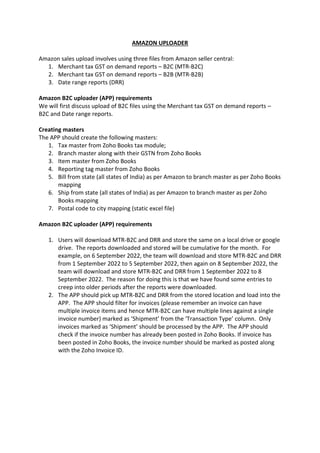
Amazon B2C Uploader APP Requirements
- 1. AMAZON UPLOADER Amazon sales upload involves using three files from Amazon seller central: 1. Merchant tax GST on demand reports – B2C (MTR-B2C) 2. Merchant tax GST on demand reports – B2B (MTR-B2B) 3. Date range reports (DRR) Amazon B2C uploader (APP) requirements We will first discuss upload of B2C files using the Merchant tax GST on demand reports – B2C and Date range reports. Creating masters The APP should create the following masters: 1. Tax master from Zoho Books tax module; 2. Branch master along with their GSTN from Zoho Books 3. Item master from Zoho Books 4. Reporting tag master from Zoho Books 5. Bill from state (all states of India) as per Amazon to branch master as per Zoho Books mapping 6. Ship from state (all states of India) as per Amazon to branch master as per Zoho Books mapping 7. Postal code to city mapping (static excel file) Amazon B2C uploader (APP) requirements 1. Users will download MTR-B2C and DRR and store the same on a local drive or google drive. The reports downloaded and stored will be cumulative for the month. For example, on 6 September 2022, the team will download and store MTR-B2C and DRR from 1 September 2022 to 5 September 2022, then again on 8 September 2022, the team will download and store MTR-B2C and DRR from 1 September 2022 to 8 September 2022. The reason for doing this is that we have found some entries to creep into older periods after the reports were downloaded. 2. The APP should pick up MTR-B2C and DRR from the stored location and load into the APP. The APP should filter for invoices (please remember an invoice can have multiple invoice items and hence MTR-B2C can have multiple lines against a single invoice number) marked as ‘Shipment’ from the ‘Transaction Type’ column. Only invoices marked as ‘Shipment’ should be processed by the APP. The APP should check if the invoice number has already been posted in Zoho Books. If invoice has been posted in Zoho Books, the invoice number should be marked as posted along with the Zoho Invoice ID.
- 2. 3. The invoices which are not yet posted in Zoho Books should be posted as per the below mapping: Merchant tax GST on demand reports – B2C Zoho Books Seller GSTN This should be mapped to the branch GSTN that is selling the goods physically. -NA- Customer name will always be Amazon (b2C) Invoice Number Invoice Number Bill from state Place of supply – We need to ensure that this is limited to the states against which branches are created and can be picked from the ‘Bill from State to Branch Mapping’. For example, if the bill from state in the Amazon report is Gujarat and there is no branch set up in Gujarat in Zoho Books, the posting should fail with the preferred error message ‘Branch not available in Bill from State’. Ship from state Source of supply – This is the list of branches available in the branch master and can be picked from the ‘Ship from State to Branch Mapping’. If branch is not available in ship from state, then the posting should fail with the preferred error message ‘Branch not available in. Ship from State’ Order Number Order Number Invoice Date Invoice Date Terms Due on receipt Ship to postal code Zoho Books invoice module has a custom city field. The city should be looked up from the Postal code to city mapping master file. -NA- Zoho Books invoice module has a custom payment type field. The payment type is available in the Amazon date range report. The order ID in the MTR-B2C should be looked up against the order ID in DRR to obtain the payment type. If payment type contains the word ‘Electronic’ then ‘Prepaid’ should be populated as the payment type else CoD should be
- 3. populated as the payment type. If payment type is not available, then the posting should fail with the preferred error message ‘Payment type not available’. -NA- Item Rates are ‘Tax Inclusive’ Invoice items SKU This should be populated in the item details field. Invoice items SKU should be validated against the item master SKU. If SKU is not available, then the posting should fail with preferred error message ‘SKU not available’. Please note that in this case if the invoice has multiple line items and even there one mismatch then the entire invoice record should fail. Invoice item quantity This should be populated in the quantity field. The APP should check if quantity is greater than or equal to inventory quantity in the ‘Source of Supply’ branch. If there is no inventory available, then the posting should fail with preferred error message ’Inventory not available’. Please note that in this case if the invoice has multiple line items and even there one mismatch then the entire invoice record should fail. Invoice amount Rate Tax rates If bill from state and ship from state is different, then IGST rates should be applied else SGST and CGST rates should apply. The tax rate in the invoice should be validated against the tax rate in the item master. For example, if the MTR-B2C has a tax rate of 18% for the invoice line item then SKU in the item master of Zoho Books should also have 18%. If there is a tax mismatch, then the posting should fail with the preferred error message ‘Tax rate mismatch’. Please note that in this case if the invoice has multiple line items and even there one mismatch then the entire invoice record should fail.
- 4. -NA- Sales channel will always be ‘Amazon.in’ from the reporting tag master. This should be applied at an invoice line item level.
